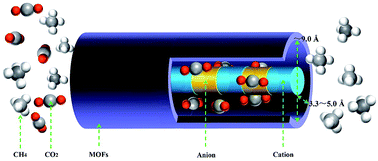Large-scale computational assembly of ionic liquid/MOF composites: synergistic effect in the wire-tube conformation for efficient CO2/CH4 separation†
Abstract
Ionic liquid/metal–organic framework (IL/MOF) composites show great potential in CO2 capture. Here, we report a large-scale computational assembly of 550 357 IL/MOF composites for CO2/CH4 separation by developing a configurational-bias Monte Carlo (CBMC)-based incorporation method rather than applying the long-time Molecular Dynamics (MD) method. The introduction of ILs into MOFs shows both improvement and good balance of selectivity and working capacity. The results show that the high performing IL/MOF composites are mainly the wire-tube type structures originating from 1,3-dimethyl-imidazolium tetrafluoroborate [MMIM][BF4] and MOFs in sql topology with a pore size of ∼9 Å, in which ILs are well confined in the MOFs to form the continuous, cation–anion alternately connected electronic nanowires. This work finds that synergistic adsorption sites can be formed in this wire-tube structure with a suitable size, providing useful information that can guide the future design of IL/MOF composites with improved CO2 capture performance.



 Please wait while we load your content...
Please wait while we load your content...